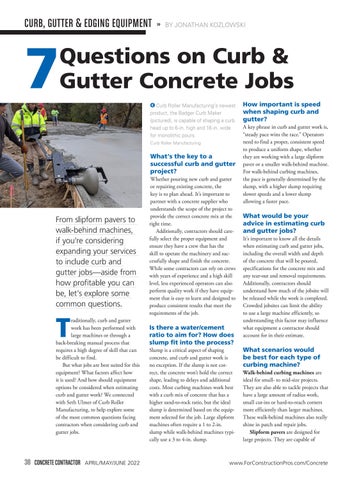CURB, GUTTER & EDGING EQUIPMENT
7
»
BY JONATHAN KOZLOWSKI
Questions on Curb & Gutter Concrete Jobs Curb Roller Manufacturing’s newest product, the Badger Curb Maker (pictured), is capable of shaping a curb head up to 6-in. high and 18-in. wide for monolithic pours. Curb Roller Manufacturing
What’s the key to a successful curb and gutter project?
From slipform pavers to walk-behind machines, if you’re considering expanding your services to include curb and gutter jobs—aside from how profitable you can be, let’s explore some common questions.
T
raditionally, curb and gutter work has been performed with large machines or through a back-breaking manual process that requires a high degree of skill that can be difficult to find. But what jobs are best suited for this equipment? What factors affect how it is used? And how should equipment options be considered when estimating curb and gutter work? We connected with Seth Ulmer of Curb Roller Manufacturing, to help explore some of the most common questions facing contractors when considering curb and gutter jobs.
38 CONCRETE CONTRACTOR
APRIL/MAY/JUNE 2022
Whether pouring new curb and gutter or repairing existing concrete, the key is to plan ahead. It’s important to partner with a concrete supplier who understands the scope of the project to provide the correct concrete mix at the right time. Additionally, contractors should carefully select the proper equipment and ensure they have a crew that has the skill to operate the machinery and successfully shape and finish the concrete. While some contractors can rely on crews with years of experience and a high skill level, less experienced operators can also perform quality work if they have equipment that is easy to learn and designed to produce consistent results that meet the requirements of the job.
Is there a water/cement ratio to aim for? How does slump fit into the process? Slump is a critical aspect of shaping concrete, and curb and gutter work is no exception. If the slump is not correct, the concrete won’t hold the correct shape, leading to delays and additional costs. Most curbing machines work best with a curb mix of concrete that has a higher sand-to-rock ratio, but the ideal slump is determined based on the equipment selected for the job. Large slipform machines often require a 1 to 2-in. slump while walk-behind machines typically use a 3 to 4-in. slump.
How important is speed when shaping curb and gutter? A key phrase in curb and gutter work is, “steady pace wins the race.” Operators need to find a proper, consistent speed to produce a uniform shape, whether they are working with a large slipform paver or a smaller walk-behind machine. For walk-behind curbing machines, the pace is generally determined by the slump, with a higher slump requiring slower speeds and a lower slump allowing a faster pace.
What would be your advice in estimating curb and gutter jobs? It’s important to know all the details when estimating curb and gutter jobs, including the overall width and depth of the concrete that will be poured, specifications for the concrete mix and any tear-out and removal requirements. Additionally, contractors should understand how much of the jobsite will be released while the work is completed. Crowded jobsites can limit the ability to use a large machine efficiently, so understanding this factor may influence what equipment a contractor should account for in their estimate.
What scenarios would be best for each type of curbing machine? Walk-behind curbing machines are ideal for small- to mid-size projects. They are also able to tackle projects that have a large amount of radius work, small cut-ins or hard-to-reach corners more efficiently than larger machines. These walk-behind machines also really shine in patch and repair jobs. Slipform pavers are designed for large projects. They are capable of
www.ForConstructionPros.com/Concrete
